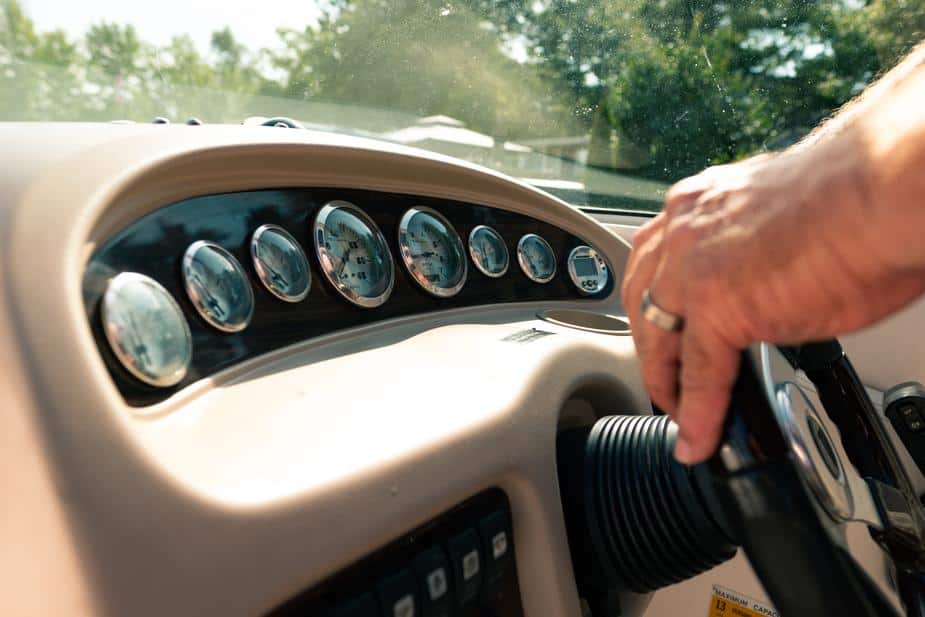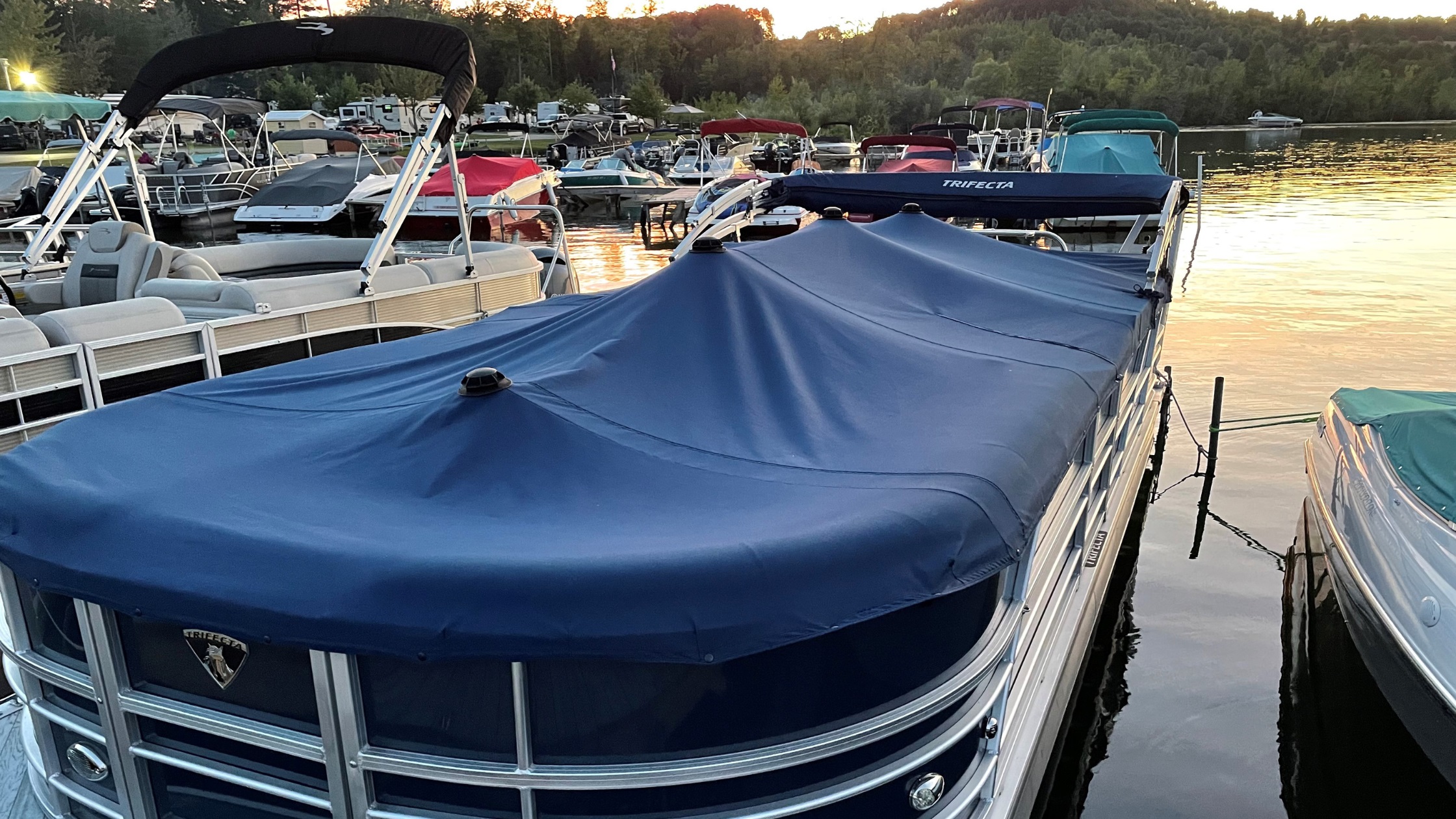Before taking it out on the water, you must know as much about your new pontoon boat as possible. You’ll also want to practice and review all the controls until you feel confident controlling them on the water. It’s hard work, but you’ll be much safer on the boat.
You drive a pontoon boat by first understanding your boat and its safety features. Then, you’ll turn the motor on, slowly pull away from the dock, and follow speed guidelines in the water. You’ll need to practice to gain confidence in taking your boat on the water.
There’s a lot to know about driving a pontoon boat. In this article, you’ll learn about how to safely control yours. Once you learn to maneuver the boat on the water, you’ll want to keep practicing as much as possible.
1. Understand Pontoon Boats and Safety
Before you take your pontoon boat out on the water, you must understand how to operate it safely. Many companies will offer you a demo ride before buying the boat. During the demo, you should ask the captain about controlling your boat and its safety features.
You’ll also need to understand local laws and have the required safety equipment on board. Generally, you will need to have the following with you on the boat:
- A working fire extinguisher.
- Your state registration sticker on the boat’s exterior.
- Any boat registration documents.
- A wearable life jacket for every person on the boat.
- A throwable personal floatation device.
- Distress signals in case of an emergency (flares or distress flags).
- Something to make a loud noise, like a whistle or air horn (not the boat’s horn).
Of course, safety laws can vary depending on what state you’re in. You’ll need to review them and ensure you can comply before you get your boat into the water for the first time. Plus, every pontoon model varies slightly, so you’ll need to know where the safety features are on your unique boat first.
Know What To Do in Rough Water
You’ll also want to know what to do in rough water if caught in it. Pontoon boats do fine in choppy water, but that doesn’t mean you should seek them out. They’re very stable since they have two hulls, which can help prevent them from tipping.
First, consider anchoring the pontoon boat if you can’t return to shore. If that’s impossible, you must learn to navigate the waves. Instead of riding into them, you want to hit them at an angle of about 45 degrees. Hitting the waves head-on can cause the front of the boat to dip in the water.
Lastly, make sure you don’t slow down between waves. Doing so can cause water to enter the boat as it crashes over you. Overall, it’s best to dock the boat and get out of the water when you notice a storm approaching. I recommend keeping a close eye on weather apps when boating.

2. Learn The Mechanics For Driving Pontoon Boats
Next, you need to get more comfortable with your pontoon boat. You should know what every button, switch, and gauge on it does and when to use them.
Here are all of the most essential controls that you’ll need to know about:
- Throttle Shift: The shift on the right side of the boat that controls your speed. Push it forward to move forward, and pull it back to go in reverse. Drawing it back also acts as a brake. Leave it in the center to remain in neutral.
- Trim Buttons: Buttons on or around the throttle shift that raise or lower the propeller on the back of the boat. You want to make sure you have it raised when in shallow water.
- Battery Switch: The knob you use to turn the boat’s battery on.
- Safety Lanyard: Many pontoons come with a safety lanyard. The boat won’t start if it senses you don’t have it hooked on your person.
- Ignition: The slot you put your keys in to start the boat. It must be in neutral, or the engine won’t start.
- Battery Level Gauge: An instrument on your dashboard showing your boat’s battery charge.
- Engine Temperature Gauge: You’ll need to keep an eye on the reading to ensure you don’t overheat the engine. Most pontoons need to remain between 160°F to 180°F (about 70°C to 82°C). You can also find it on your dash.
- Fuel Gauge: An instrument on the dash that tells you how much fuel you have for your boating trip. You want to ensure you have enough to not get stranded in the water.
3. Turn the Motor On
Before setting out, ensure you and your passengers wear a well-fitting life jacket. Turn the boat’s battery switch to the on position, then connect the emergency lanyard to your person. Most people hook it onto one of their belt loops. Turn the emergency switch by the lanyard to “RUN” or “ON.”
Drop the propeller into the water; it should be trimmed down before you start the motor. Once it’s under the water, put the key in the ignition, and turn it to start the motor. You’ll be able to hear the engine come on.
Finally, before you start your trip, check these three things:
- Your boat has enough fuel to leave and come back.
- The engine temp is in a reasonable range.
- The battery has enough power.
4. Slowly Pull Away From the Dock
Now it’s time to get out on the water! You must move the boat slowly and deliberately away from the dock. Once ready, remove any lines connecting you to the dock and push off.
Slowly push the throttle away from you to gradually build speed. You don’t want to move fast until you’re far from the dock.
Then, you can use the throttle to control your speed.
5. Use the Throttle To Control Your Speed

Now that you’re on the water, you can use the throttle and steering wheel to control the boat. The throttle lets you speed up, stop, and go in reverse. If it’s your first time driving the pontoon, make sure to keep the boat at a slower speed until you build more confidence in controlling it.
There are no brakes on the boat. When you want to stop, you must move the throttle into reverse. Doing so can help you stop faster since the boat will keep some momentum if you just put it into neutral. It’s best to think of neutral on the throttle, like parking in a car.
Take a gander at our artilcle on: How To Dock A Pontoon Boat (Important Tips!)
6. Docking Your Pontoon Boat
Docking your pontoon boat for the first time can be tricky, so take as much time as you need to do it properly.
Here’s what you should do:
- Approach the dock on the side you want the pontoon to be on.
- Ready the dock lines before getting close.
- Remain aware of your surroundings and watch for obstacles.
- Stand up to better view the front of the boat.
- Put the throttle in reverse to stop the boat.
- Shift into neutral when the boat stops.
- Grab the dock lines and tie them to the cleats.
- Turn off the engine.
- Turn off the emergency lanyard and battery.
- Make sure everyone can get off safely.
It’s also essential to know if you’re docking your boat in a legal place. You wouldn’t want to get caught up in legal trouble regarding where you left your pontoon.
Check out this article we have on: Where is it legal to tie up your boat.
7. Practice Driving Your Pontoon Boat Often
The more you take your pontoon boat out in the water, the more comfortable you’ll feel. It can take a few trips to get a feel for your boat’s handling. Practicing with a co-captain is also good since you won’t want to be alone on the water until you’ve spent more time driving the pontoon.
You’ll want to take your boat out on the water as often as possible. The more you practice, the better you’ll feel driving it. Eventually, it’ll become second nature to you, like riding a bike or a car!
(PAA) Is a Pontoon Boat Easy To Drive?
Pontoon boats are easy to drive once you know the controls. They are simple to control at slower speeds, making them a good way for beginners to learn boating. You’ll want to take your time on the water and move slowly until you know what you’re doing.
These boats are also much safer than other boats, as long as you don’t take them out in choppy waters. Pontoons don’t have a high chance of flipping over. They come with plenty of safety features, including emergency lanyards and railings.
Pontoon boats also have the benefit of being easy to maintain. You must have it serviced yearly to keep it in good condition, but caring for them is very straightforward.
Final Thoughts
To summarize, you must understand your pontoon before driving it. Each boat has slightly different controls, although they’ll always have the throttle in a similar place. You’ll also want to familiarize yourself with safety features and local laws.
After that, you can turn on the motor, then use the throttle to control the speed of your boat. Pontooning is a lot of fun, but you will want to get in as much practice as possible.
Project “Get Boating!“ Boating
Check out our article on: How To Dock A Pontoon Boat (Important Tips!)

